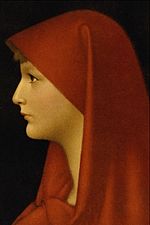Saint Fabiola facts for kids
Quick facts for kids SaintFabiola |
|
|---|---|

Copy of Henner's portrait of St. Fabiola.
|
|
| Born | Rome, Italy |
| Died | 27 December 399 a.d. |
| Venerated in | Roman Catholic Church |
| Canonized | Pre-Congregation |
| Feast | 27 December |
| Patronage | Divorced people, difficult marriages, victims of abuse; unfaithfulness, widows; Hospice Movement |
Fabiola was a kind and noble Roman woman who lived a long time ago. She was known for being a nurse and a helper to those in need. Influenced by a wise church leader named Jerome, Fabiola decided to dedicate her life to helping others and doing good deeds. She used her wealth and time to practice Christian charity, which means showing love and kindness to everyone.
Contents
Fabiola's Early Life and Family
Fabiola came from a very old and important Roman family called the Fabia gens. She had a difficult first marriage. Later, after her second partner passed away, she chose to live a life focused on helping others.
When Jerome was in Rome (around 382-384 AD), Fabiola was not yet part of his group of devoted followers. It was after her second partner's death that she decided to change her life completely.
One day, before Easter, she went to the Lateran basilica in Rome. She wore simple clothes to show her commitment to a new way of life. This act made a big impression on the Christian people of Rome. The pope welcomed her back into the church.
Helping the Poor and Sick
After this, Fabiola gave up her fancy lifestyle. She used her huge amount of money to help poor and sick people. She built a special hospital in Rome. Fabiola even worked there herself, taking care of patients. She helped people who had serious illnesses that others often avoided.
She also gave a lot of money to churches and religious groups in Rome and other parts of Italy. Fabiola cared deeply about the church and helping those who were suffering.
In 395 AD, Fabiola traveled to Bethlehem. There, she lived in a hospice (a place for travelers and the sick) run by Paula of Rome. Under Jerome's guidance, she studied the Bible with great passion. She also practiced spiritual exercises.
However, life in Bethlehem became difficult. There was an attack by the Huns in the eastern parts of the empire. Also, a disagreement happened between Jerome and another church leader about certain teachings. Because of these problems, Fabiola returned to Rome.
Continuing Her Good Work
Even after returning to Rome, Fabiola stayed in touch with Jerome. She asked him to write a special paper about the priesthood. In Rome, Fabiola teamed up with a former senator named Pammachius. Together, they started a big charity project. They built a large hospice at Portus for pilgrims (people traveling for religious reasons) coming to Rome.
Fabiola continued her personal work helping the poor and sick until she passed away. She died on December 27, 399 AD, or possibly 400 AD. Fabiola's work showed how early Christian women were involved in helping people with medicine and care.
Remembering Saint Fabiola
Fabiola's funeral was a huge event. It showed how much the people of Rome appreciated and respected her. Jerome wrote a beautiful letter praising Fabiola to her relative, Oceanus.
Another important church leader, Augustine of Hippo, also wrote a letter dedicated to her.
Fabiola's Lasting Legacy
Cardinal Wiseman wrote a famous novel about her called Fabiola. He wrote this book partly to respond to another book that was against Catholics. Wiseman's novel helped support the Catholic community in England at the time.
The artist Jean-Jacques Henner painted a famous portrait of Fabiola in 1885. This painting shows her in a classical Roman style. The original painting was lost in 1912. However, many artists around the world copied the image over the next century.
In 2008, a modern artist named Francis Alÿs created a special art show. He collected over 300 copies of Henner's portrait of Fabiola. This exhibition traveled to different museums, including the Hispanic Society of America in New York City and the LACMA in Los Angeles. It also went to the National Portrait Gallery in London. Later, the collection grew to 514 copies and was shown in Houston.
See also
In Spanish: Fabiola de Roma para niños

